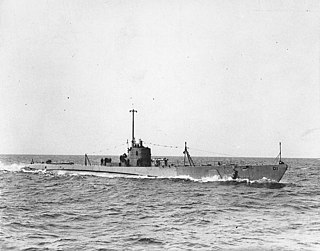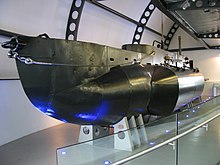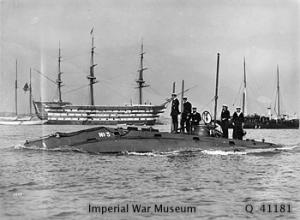
The Royal Navy (RN) is the United Kingdom's naval warfare force and a component of His Majesty's Naval Service. Although warships were used by English and Scottish kings from the early medieval period, the first major maritime engagements were fought in the Hundred Years' War against France. The modern Royal Navy traces its origins to the early 16th century; the oldest of the UK's armed services, it is consequently known as the Senior Service.

The Amphion class of British diesel-electric submarines were designed for use in the Pacific War. Only two were completed before the end of hostilities, but following modernisation in the 1950s, they continued to serve in the Royal Navy into the 1970s.

USS Dolphin (SF-10/SC-3/SS-169), a submarine and one of the "V-boats", was the sixth ship of the United States Navy to be named for that aquatic mammal. She also bore the name V-7 and the classifications SF-10 and SC-3 prior to her commissioning. She was launched on 6 March 1932 by the Portsmouth Navy Yard, sponsored by Mrs. E.D. Toland, and commissioned on 1 June 1932.

The V-boats were a group of nine United States Navy submarines built between World War I and World War II from 1921 to 1934 under authorization as the "fleet boat" program.

A midget submarine is any submarine under 150 tons, typically operated by a crew of one or two but sometimes up to six or nine, with little or no on-board living accommodation. They normally work with mother ships, from which they are launched and recovered and which provide living accommodation for the crew and support staff.

HMS A3 was an A-class submarine built for the Royal Navy in the first decade of the 20th century. She sank in 1912. The wreck is a Protected Wreck managed by Historic England.
HMS A5 was an early Royal Navy submarine. She was a member of Group Two of the first British A class of submarines. Like all members of her class, she was built at Vickers Barrow-in-Furness.

The seventeenth Royal Navy vessel to be named HMS Dolphin was the Royal Naval shore establishment sited at Fort Blockhouse in Gosport. Dolphin was the home of the Royal Navy Submarine Service from 1904 to 1999, and location of the Royal Navy Submarine School.

Holland 1 is the first submarine commissioned by the Royal Navy. The first in a six-boat batch of the Holland-class submarine, she was lost in 1913 while under tow to be scrapped following her decommissioning. Recovered in 1982, she was put on display at the Royal Navy Submarine Museum, Gosport. Her battery bank found in the boat was discovered to be functional after being cleaned and recharged.

HMS Alliance(P417/S67) is a Royal Navy A-class, Amphion-class or Acheron-class submarine, laid down towards the end of the Second World War and completed in 1947. The submarine is the only surviving example of the class, having been a memorial and museum ship since 1981.

HMS Otus was a Royal Navy Oberon-class submarine launched in 1962. She was decommissioned in the early 1990s and is now a naval museum in Germany.

The Royal Navy Submarine Service is one of the five fighting arms of the Royal Navy. It is sometimes known as the Silent Service, as submarines are generally required to operate undetected.
Fleet Support Limited (FSL) is a British company formed to run HMNB Portsmouth's Fleet Maintenance and Repair Organisation (FMRO) on a commercial basis. The FMRO was an agency of the Ministry of Defence responsible for repair and maintenance of Royal Navy vessels. FSL performs this task but also undertakes commercial work such as shiprepair, refitting, conversion and hull fabrication. FSL also carries out heavy engineering work and nondestructive testing for the marine and engineering sectors.

HMS Tiptoe was a British submarine of the third group of the T class. She was built by Vickers Armstrong, Barrow, and launched on 25 February 1944. She was one of two submarines named by Winston Churchill, and so far has been the only ship of the Royal Navy to be named Tiptoe. In 1955 she was involved in a collision with a coastal steamer whilst in Tromsø harbour. She was involved in escape trials off Malta in 1962, and the commanding officer was reprimanded in 1964 following an incident in the Firth of Clyde where she was run aground, and again in 1965 when she collided with HMS Yarmouth. Although originally named for the ability to sneak up on someone undetected, she maintained several links with ballet, including the Royal Ballet and ballet dancer Moira Shearer. She was scrapped at Portsmouth in 1975, while her anchor is on display in Blyth, Northumberland.

HMS Conflict was the lead ship of the Conflict-class destroyers built by J. Samuel White, at East Cowes, Isle of Wight for the Royal Navy. She was launched on 13 December 1894, and entered service in 1899. After an initial spell in the Mediterranean Fleet, Conflict returned to British waters, where she served the rest of her career. Conflict was part of the Portsmouth Local Defence Flotilla during the First World War, which she survived. Conflict was sold for scrap on 20 May 1920.

HMS Phoenix was a Parthian-class submarine of the Royal Navy, launched in 1929. She was the eighteenth warship of the Royal Navy to use the name Phoenix. She served on the China Station from her commissioning until the start of the Second World War. Phoenix was then relocated to the Mediterranean Sea and was sunk by the Italian torpedo boat Albatros on 16 July 1940.

The Jolly Roger is a symbol that has been used by submarines, primarily those of the Royal Navy Submarine Service and its predecessors. The practice came about during World War I: remembering comments by First Sea Lord Admiral Sir Arthur Wilson, who complained that submarines were "underhanded, unfair, and damned un-English" and that personnel should be hanged as pirates, Lieutenant Commander Max Horton began flying the flag after returning from successful patrols. Initially, Horton's submarine HMS E9 flew an additional flag after each successful patrol, but when there was no room for more, the practice was changed to a single large flag, onto which symbols indicating the submarine's achievements were sewn.

Fremantle submarine base was the utilisation of Fremantle Harbour as a submarine base in World War II. The submarine base was second only to Pearl Harbor in the Pacific theatre, with US, British and Dutch submarines operating from Fremantle during the war. US submarines operating from Fremantle accounted for approximately one quarter of all US submarine patrols in the Pacific.
Captain William Richmond Fell, was a New Zealand naval officer. He served in the Royal Navy, mainly in submarines, and was involved in the development of human torpedoes and midget submarines during the Second World War.




















